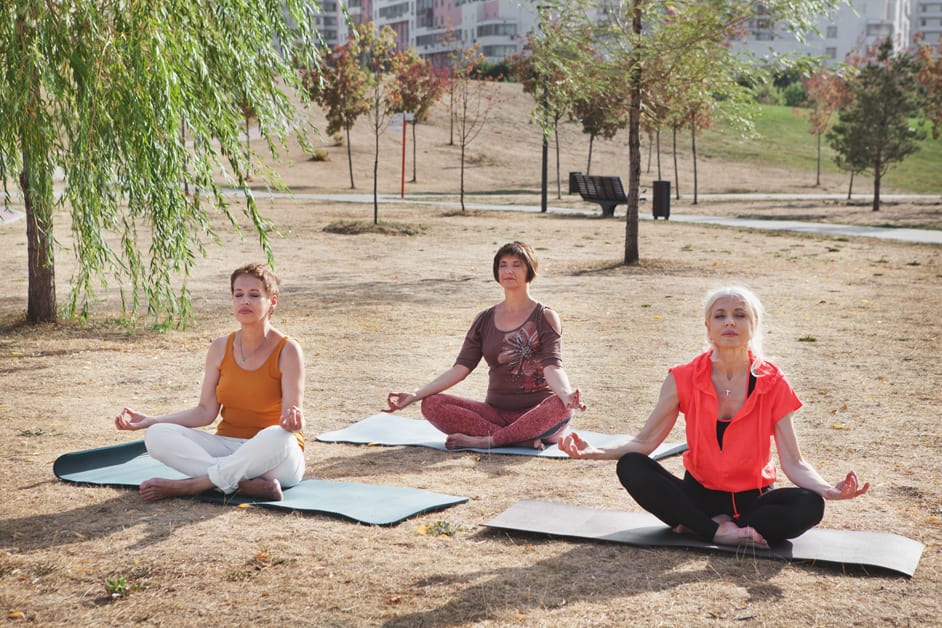Introduction
Patellofemoral Pain Syndrome (PFPS) is a very common issue. It impacts your knee joint and can stop you from doing everyday activities. To get better, physical therapy and/or surgery may be necessary. However, yoga can be helpful too! In this article, we will learn more about PFPS. Plus, we will look at five yoga poses to ease the pain of this condition.
What is Patellofemoral Pain Syndrome?
Patellofemoral Pain Syndrome (PFPS) is a common knee issue amongst athletes. It affects around 1 in 4 active people. It is characterised by chronic pain surrounding the kneecap and can cause decreased mobility and difficulty with everyday tasks.
The cause is unknown, but it is thought that overuse, increased pressure on the patella, or a sudden increase in physical activity could be triggers. Symptoms include aching pain, clicking noises from the knee joint when bent or stretched, swelling and tenderness around the kneecap, and difficulty with activities such as stair climbing, squatting or jumping.
Coping with PFPS can be hard, yet there are ways to manage the pain. One method is yoga, particularly poses that stretch tight muscles in the legs and core areas. If you would like to learn more about how yoga can help with PFPS, read on!
Benefits of yoga for PFPS
Yoga can help with Patellofemoral Pain Syndrome (PFPS). The gains are: reducing inflammation, more range of motion and strength, proper joint alignment and posture, better proprioception and coordination, improved balance and mobility, relaxation, and less stress. These together can reduce the pain of PFPS.
Yoga poses for PFPS are:
- Standing Forward Fold (Uttanasana)
- High Lunge Variations (Anjaneyasana)
- Fish Pose (Matsyasana)
- Crescent Lunge Variations (Anjaneyasana)
- Extended Puppy Pose (Adho Mukha Svanasana)
- Reclining Big Toe Pose Variation (Supta Padangusthasan)
When practicing yoga for PFPS, check your body’s alignment. Keep good posture to stop damage to the knee joint. Don’t push too hard when starting, as it can cause more problems. Regular practice will help improve strength, mobility and stability in the patellofemoral joint area – leading to long-term relief from PFPS.
Preparation
Before trying yoga to ease PFPS, take a few moments to get your body ready. Preparations include warming and cooling your muscles. Consult a physical therapist to ensure the poses you do are helping your pain.
Here’s a look at the steps necessary to practice yoga for PFPS:
Warm up
It’s important to warm up your muscles before beginning yoga poses. This helps decrease risk of pain or injury. Warming up also helps your connective tissues get ready for the stretching activities and gets your blood flowing.
Start with mountain pose for 4-5 breaths. This will help with your oxygen intake and slightly flex and extend key muscle groups, similar to a short jog before a workout or race. Mountain pose also helps with posture and being mindful, two foundations of many yoga practices.
Once you feel warmed up, proceed with the five yoga poses that can help ease pain due to PFPS. Don’t push too hard or go further than your flexibility level; each of the five poses should be held no longer than 10 breaths before moving to the next pose or repeating the cycle. Breathe in deeply before each pose and breathe out when you’re done; conscious breathing is an essential part of successful yoga practice!
Breath work
Breath is essential for yoga. It helps you focus and relax. Breath work also lets you go deeper into poses and have proper form.
Inhale in two or three seconds. Exhale in four or five seconds. A metronome or other rhythm-keeping device can help you count. Ultimately, your breath should be automatic.
Ujjayi breath is one way to coordinate with poses. It’s like waves lapping against a shore, and is heard through your nose. The sound calms your mind and reminds you to breathe deeply. Ujjayi works best when it matches the pace of the pose.
- Slow for easy poses;
- fast for tough ones.
Pose 1: Cat-Cow
Crazy Cat-Cow! A sequence for relaxation that is gentle and soft. It lengthens the spine and reduces tension, while also promoting flexibility. This restorative pose creates a natural rhythm to open the body. It may even be helpful for those with Patellofemoral Pain Syndrome (PFPS). Its effects reduce tension in the muscles, ligaments, and tendons around the knee joint.
Instructions
Kneel on your yoga mat. Hands under shoulders, knees beneath hips. Head and neck in a neutral position. Engage core muscles.
Inhale, move chin in and arch back – creating a “cat” shape. Don’t press too much in lower back – could cause injury. Rock back and forth between “cat” and “cow” – each inhalation: “cat“, each exhalation: “cow“. 5-10 breaths.
To finish: child’s pose. Sink onto your heels, forehead lightly on ground. Take deep breaths. When ready, slowly emerge from pose.
Benefits
Cat-Cow pose has lots of benefits. These include:
- Greater flexibility
- More muscle strength
- Improved posture and balance
- Better circulation to the knee joint
- Improved joint mobility
- Less pain from overuse or age
Plus, it helps with body awareness and strengthens your core muscles.
Stretching out the connective tissues around your spine helps with spinal alignment and control. This is important for reducing tension in the knee joint, which is often linked with Patellofemoral Pain Syndrome. It can also reduce inflammation and tenderness while providing knee pain relief. Regularly doing this pose also gives the knee joint more lubrication. This helps with joint flexibility and range of motion, making it easier to do activities like walking.
Pose 2: Wide-Legged Child’s Pose
Yoga’s Child’s Pose can be a blessing for easing the agony of Patellofemoral Pain Syndrome. Spread your legs wide, feet together and knees apart. To intensify the pose, bring your chest to the floor. This pose can help with flexibility and diminish the tension in your hips and legs.
Instructions
Come to child’s pose.
- Bring your knees together and sit on your heels.
- Open your legs wide, with the soles of your feet touching the floor.
- Reach forward and place your hands on the floor.
- Walk your hands forward, using your core for support.
- Hold the stretch for 30 seconds, breathing deeply.
- Return your hands to center.
- Uncurl your body and come back to your heels.
Benefits
Wide-Legged Child’s Pose can provide many advantages for those with patellofemoral pain syndrome (PFPS). It opens the hips, stretches the quads, hamstrings and calves. Lengthening the spine may help better posture and lessen the stress on the knees.
The relaxation effects of this pose can reduce muscle and joint tension, which helps to lessen PFPS-related knee pain. Also, this pose doesn’t stretch the affected knee much, making it a good alternative when PFPS flares up.
Pose 3: Reclined Figure Four
Try the Reclined Figure Four! It’s great for when you have PFPS. It opens up both your hips and increases flexibility. It also stretches your abdominals, hips, and inner thigh muscles.
Make sure to warm up first. And be aware of any pain or discomfort while doing the pose.
Instructions
Start in dandasana (staff pose) on the floor. Put your right ankle on top of your left quadriceps. Inhale and raise your arms above your head and make a slight backbend. Hold it for 5 deep breaths, breathing through your nose.
Exhale and spread both your cheeks to the mat and lift your arms up, close to your ears. Move your chest closer to the floor. Rest in this reclined figure four position. Do this a few times, with controlled movements, while taking breaths.
To go deeper, bring your front knee towards midline by pushing your right foot against your left thigh. This will open up your inner thighs, hips, sacroiliac joint and groins. Stay here for 8-10 deep breaths, then exhale and go back to staff pose or just lie down on one side and rest. After that, sit up again.
Benefits
Reclined Figure Four is a great pose for reducing patellofemoral pain syndrome. It stretches hip muscles and improves flexibility. Plus, it strengthens gluteal muscles, relieving knee tension.
Lie on your back with one leg bent, crossing it over your other thigh. Use a strap or towel around each foot to deepen the pose. This creates an external rotation and stretches muscles like TFL, IT band and adductors.
Regular Reclined Figure Four practice brings flexibility to the hip capsule and improved range of motion. It also has other benefits like:
- Better posture
- Less backaches
- More circulation
- Lower stress levels
Pose 4: Downward Facing Dog
Downward Facing Dog! A great pose for those with Patellofemoral Pain Syndrome. It offers a gentle stretch to the patellar tendon, quadriceps, and hamstrings. It can also strengthen the core and help with posture.
Why is this pose beneficial for those with Patellofemoral Pain Syndrome? Let’s take a closer look.
Instructions
Downward Facing Dog is a great pose for stretching your thigh muscles. It can also help reduce stress in your lower back, hips, and shoulders.
To get into it:
- Start on all fours, palms on the floor, knees under your hips.
- Tuck your toes and lift your hips up. Push your thighs back and straighten your legs as much as possible, but leave your knees bent slightly. Make sure your feet are hip-width apart with your toes turned out slightly.
- Push your palms down, spreading your fingers wide. Your middle fingers should be facing forward and your knuckles should be pressed against the floor. Balance your weight evenly through your hands and arms.
- Pull your shoulder blades towards each other to open your chest.
- Keep your head in line with your arms, don’t let it drop too far. Look between your hands or at your navel.
- Hold the pose for 15-30 seconds, focus on deep breathing. Increase the seconds until you reach 1 minute holds.
- Release the pose by lowering your knees back onto the floor.
Benefits
The downward facing dog pose has lots of advantages for those with patellofemoral pain syndrome (PFPS). It strengthens the muscles around the knee and stretches out the hip flexors and hamstrings, allowing more movement.
The hamstring stretch also aids PFPS, enhancing stability to the knee joint and bettering pelvic alignment. Plus, it opens the chest, eases tension in tight areas and boosts knee balance.
This yoga pose increases circulation as it requires a lot of stretching in the body, relieving stiffness in the muscles. It also encourages deep breathing for a calming effect, reducing stress, mental fatigue and anxiousness.
Pose 5: Seated Forward Fold
Ready to try it? Seated Forward Fold is perfect for easing Patellofemoral Pain Syndrome. It stretches your hip flexors and quads, offering relief to the front of your knee. Plus, it widens your chest and shoulders, and loosens tension in your upper back.
Let’s dive into the pose!
Instructions
Seated Forward Fold is a pose that helps protect and brace the knees, while also stretching the muscles around the knee joint. Start by sitting with legs out in front, against a wall if possible. Bend the right leg and grab the foot with both hands. Use the elbows or forearms to press down gently on the same thigh. Huggling the knee closer to the body can help provide more support.
- Inhale, lengthen the spine and lift both arms towards the ceiling.
- Exhale, fold forward over the legs. Bringing the chest towards each foot. Keep pressure on both hips pressing down into the mat. Movement should be slow and controlled. Don’t rush! Let gravity do the work.
- Take several deep breaths here.
- When done, come back into an upright seated position. Smile and release any tension from the jaw or face.
Benefits
Seated forward fold pose, or Paschimottanasana, can stretch the hamstrings and calves. It may increase flexibility in the spine and help ease stress. It may also boost energy levels and improve digestion.
People with patellofemoral pain syndrome may find relief. This pose may help alleviate tension around the knee. It can also strengthen the back muscles and improve posture. This may reduce poor postural habits and PFPS symptoms.
It may reduce tension headaches by calming the body and mind. The mindful awareness this pose provides may help reduce stress levels.
Conclusion
Yoga is a great solution for those with patellofemoral pain syndrome. Certain poses can be used to target the pain directly. Regular practice of these poses, as well as other self-care strategies such as stretching, foam rolling and mindful meditation, can help manage the pain. Plus, you can become more aware of your body and movements.
Summary of poses
The five poses mentioned can help ease Patellofemoral Pain Syndrome due to their stabilizing and strengthening abilities. Before attempting these poses, it is crucial to consult with a physician. Additionally, warming up the muscles beforehand is essential for relaxation and less injury.
The session should start with 4 minutes of stretching. Then, move onto simpler postures before coming to the PFPS poses. Remember to practice yoga consistently so you can get the full benefits!
Additional tips for managing PFPS
Once you begin a yoga routine to help with PFPS, there are other changes to your lifestyle that can help.
- Strength-training exercises like isometric squats and step-ups are great for patients with PFPS. They help with musculoskeletal function, patellar tracking, and hip abduction force.
- It’s also helpful to wear supportive arch inserts in shoes to prevent excessive pronation. This is common for people with PFPS because of weakened or tight muscles around the thigh, knee joint, and ankle.
- Maintaining a healthy weight through diet, plus regular stretching, can reduce strain and strengthen core muscles.
- Lastly, it’s important to seek treatment early on, before symptoms worsen.
Frequently Asked Questions
Q: What is Patellofemoral Pain Syndrome?
A: Patellofemoral Pain Syndrome (PFPS) is a condition in which pain is felt in the front of the knee, around and behind the kneecap. It is a relatively common condition and is caused by a combination of factors, such as tight muscles in the thigh, weak muscles in the hip and thigh, poor alignment of the knee joint, and overuse.
Q: How can yoga help alleviate Patellofemoral Pain Syndrome?
A: Practicing yoga can be an effective form of treatment for Patellofemoral Pain Syndrome. Certain poses can help stretch and strengthen the muscles around the knee, improve alignment, and provide relief from pain.
Q: What are 5 yoga poses that can help with Patellofemoral Pain Syndrome?
A: The 5 poses which can help with Patellofemoral Pain Syndrome are: Low Lunge, Reclined Pigeon Pose, Reclined Hand-to-Big-Toe Pose, Garland Pose, and Downward-Facing Dog.





